How To Play Ragtime Piano
Lesson One – What Is Ragtime Music?
Introduction:
Ragtime music is one of the most popular forms of music since its emergence towards the end of the 19th Century.
Its appeal comes from the music is; a combination of a march and jazz.
This creates a compelling type of music where the left hand of the piano usually stays in a steady rhythmic pattern while the right-hand plays a ‘jazzy’ or ‘syncopated’ melody above.
One of the most celebrated composers of Ragtime music was Scott Joplin, whose music has entertained and inspired generations of musicians.
There were many other Ragtime composers of equal stature to Joplin that you can explore further in your own time.
For this course, I have chosen to focus on one lesser-known Rag called ‘The Pineapple Rag’ by Scott Joplin that offers us a first-class introduction into the world of Ragtime.
Many of the ‘characteristics’ of not only Joplin’s style but of the Ragtime genre are contained in The Pineapple Rag and provide an excellent basis for starting to
explore the genre.
The course aims to guide you through the critical elements of Ragtime piano playing and assumes a reasonable level of technical competency.
Although many of the exercises may be approachable and serve as a starting point for guided learning, the course is not for beginners.
The basic characteristics of Ragtime piano music.
- Syncopation is deliberately composed to be ‘off the beat.’ This is usually the right-hand or melody part of the Rag and mimics the rhythms that dominated early jazz music.
- For the most part, the striding left-hand accompaniment part of the Rag is played by the left hand. The style in which it is played is often described as ‘stride’ as the pianist must play a bass note on the beat followed quickly by the chord towards the piano’s middle register.
- Structurally Ragtime varies quite considerably but is often in a kind of Rondo form (A, B, A, C, A, D…), where the opening section (A) returns in between the contrasting areas of the music.
- Harmonically the music is tonal (written in a key), with Rags composed in major and minor keys. Over the following few lessons, I will break down Pineapple Rag into its parts to enable you to play the Rag. We begin, though, with some essential exercises that are designed to get you into the genre’s mood and address some of the points above.
Work slowly on each exercise, ensuring, in particular, that you clap through the rhythms of Ex. 1 & 4 before attempting to play them on the piano.
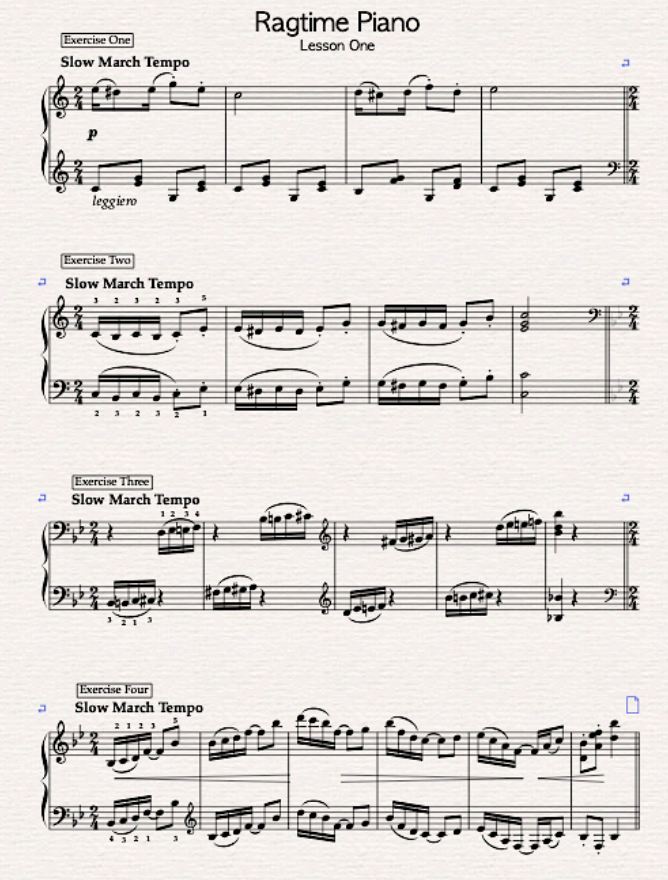
Lesson Two – The Left-Hand ‘Stride’
Why are we spending valuable Ragtime learning about a jazz technique?
Well, the fact is that this method of playing the piano dates back many years before even Jazz was thought about and can be found in the works of many Romantic composers like Schumann, Schubert, Chopin, Liszt, and Rachmaninov. (To name but a few)
It features early on in the lessons because this method of accompanying forms the bedrock for each Rag, and Pineapple Rag is no exception.
Stride piano derives its name from the way the left-hand strides from the low bass note (usually one of the strong beats of the bar) to the three or four-note chord in the mid-range of the piano.
Jazz pianists adopted this way of playing to cover the range a band might be expected to play from upright bass or Sousaphone through the banjos, trombones, and guitars to the trumpets, saxophones, and clarinets.
It’s a hard act to follow on a single instrument.
Tips:
Each exercise is written to help you develop the skill and the strength to feel more secure with stride playing.
Take your time to ‘feel’ your way across the piano keys taking care not to make the too larger a jump from bass to mid-range.
Additionally, practice without the sustain pedal.
I know this is tempting to use the sustain to smooth your way from the bass to mid-range, but you will hear more clearly how well you are progressing with the technique without pedal.
It can be added later in the learning but always with an ear towards a straightforward delivery, not a smudged one.
Work slowly through the exercises.
Take the time to memorize each of them, as this will help to embed the learning. (Remember, a great many jazz pianists do not read music).
Note that the right-hand part can be omitted first and then added in later.
The only exception is the second exercise that I feel will help you with the lefthand progressions; however, this can also be omitted if it is easier to learn.
Dynamically, try to maintain a good balance between the bass note and the chord.
Remember, the bass note imitates a string or upright bass and need not be too heavily player; more a light placing of the note that brings a subtle rhythmic emphasis to the strong beats of the bar.
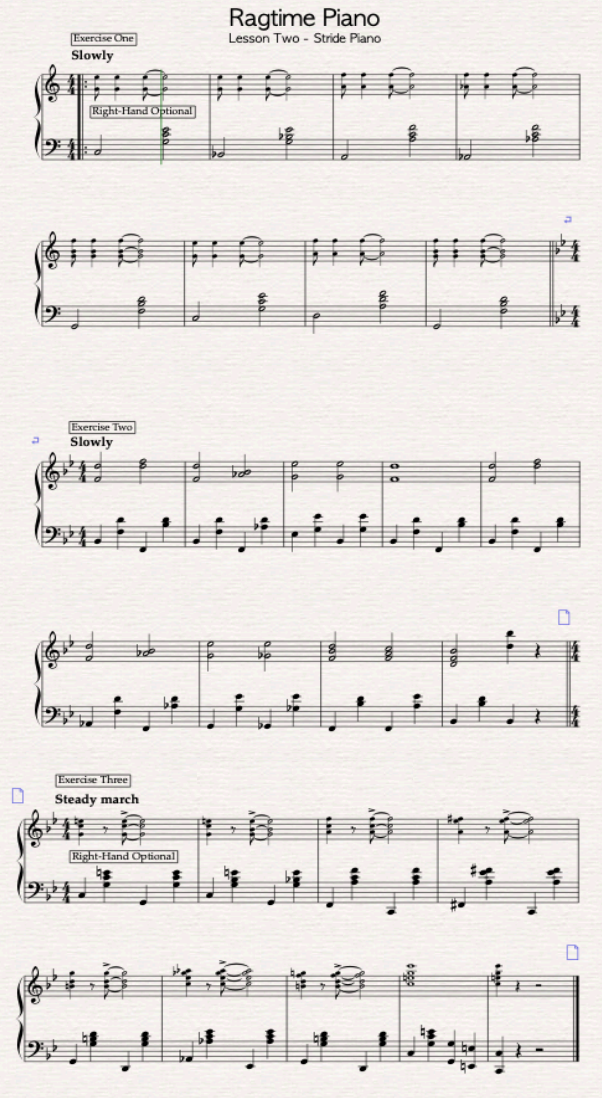
Lesson Three – Right-Hand Focus
In this lesson, we turn our focus to the right-hand of the Ragtime piano.
Having taken a brief look at ‘stride’ techniques in lesson 2, it is not time to consider what the other hand is doing while the stride accompaniment is playing.
One major feature of Ragtime music is ‘syncopation.’
This brings a quintessentially Ragtime to feel to each piece that can be challenging to master.
Often melodies deliberately are written in a syncopated manner to bring rhythmic interest to a piece that otherwise would be a march.
There are varying degrees of complexity in Ragtime compositions regarding syncopation that we need to address.
As our focus, the piece is The Pineapple Rag. I have based the exercises for this lesson on this Joplin Rag.
In this way, you will be better prepared to play this Rag and well versed in the typical syncopated figures that regularly appear in this genre of music.
Tips:
It is always good practice to clap through more challenging rhythms before playing them.
Refer to the video clip of the lesson and use this as a measure of how the rhythm should sound.
If you want to break down the exercises into bars or half-bars to ensure that the rhythms are correct, I encourage you to do so.
The left hand can be omitted but can also help stabilize and maintain a sense of pulse.
You could always make up your accompaniment if you wish.
No PEDAL yet with the exercises. Take the time to ensure smooth, confident playing.
Repeats are optional.
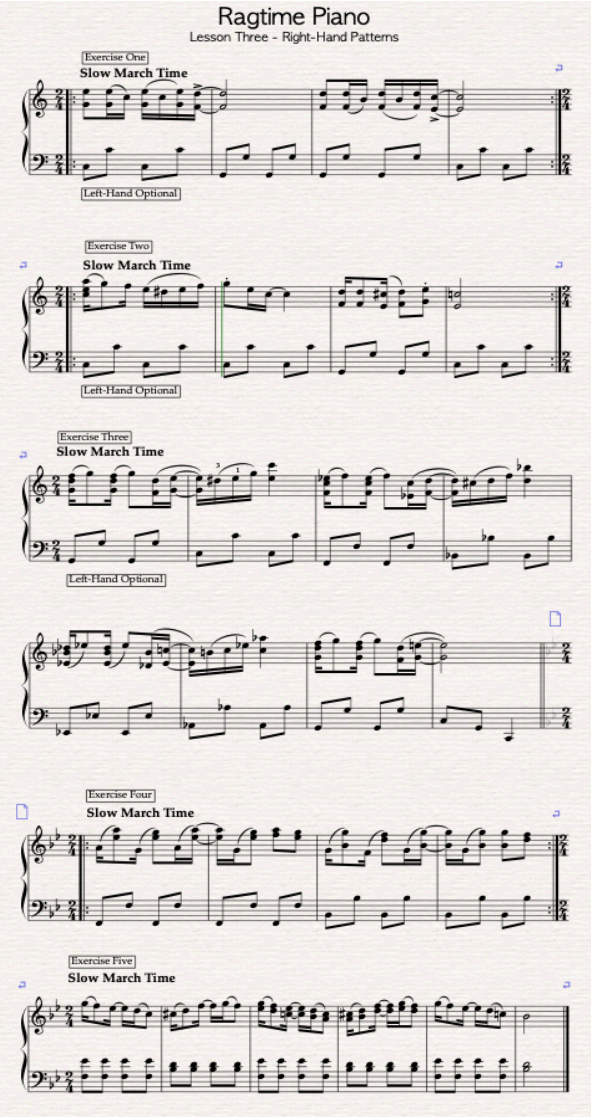
Lesson Four – Hands Together
This lesson focuses on using both hands at once on the piano.
Sometimes Ragtime requires the pianist to perform with hands playing the same idea together. At other times absolute independence is crucial.
In this session, we aim to put together some of the elements of Ragtime that we have explored in the earlier lessons and introduce one or two new ones.
Another important consideration is the balance between the hands, both in terms of dynamics (volume) and tone.
We need to be able to hear the melody, but also, the harmonic and rhythmic elements of the left hand are vital for the music to make sense.
Listening and practicing this aspect of the Rag will make the performance convincing and demonstrate technical control and understanding.
Tips:
As in the previous lessons, we are working on individual hands is a good idea.
It may be helpful to approach the exercise by learning the ‘stride’ left-hand part first, ensuring that this is rhythmically stable and under the fingers before moving forward with the right hand.
Establish the fingering patterns that work for you, and note the score.
Add any dynamics you may feel are appropriate if none are shown.
You could experiment with the sustain pedal if you wish, but try to always aim for clarity of sound and do not try to ‘cover’ a technical flaw with the pedal!
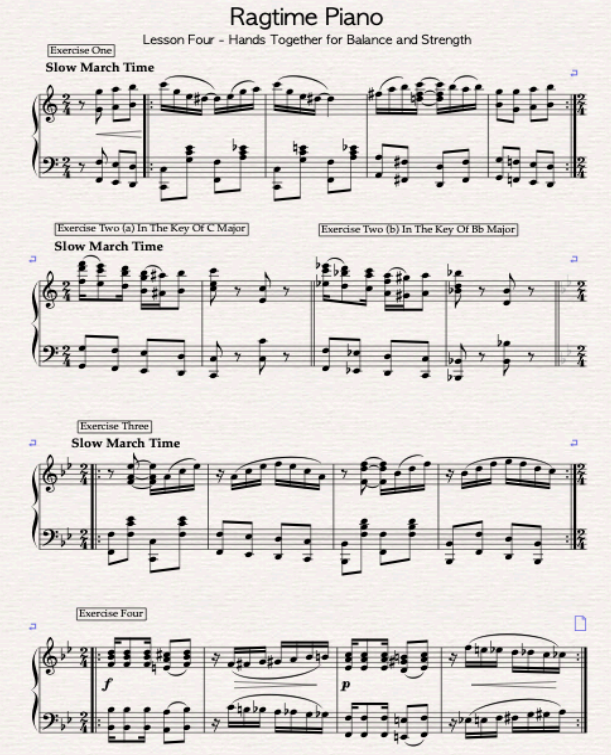
Lesson Five – The Pineapple Rag – ‘Section A’
In this lesson, we will put into practice the skills we have been building over the last four classes.
The aim here is to work through the challenges that the opening (‘A’) section of The Pineapple Rag presents.
The good news is that you will already have begun to master many of these challenges.
You may have wholly mastered these skills, in which case it is a matter of ‘fine-tuning’ these and developing performance of quality.
I have extracted the critical areas of the opening section of Pineapple Rag and developed them into ‘exercises’ or practice points.
Taken at a slow enough speed (counting in 4 quavers/eighth notes in each bar), each exercise will probably be perfectly manageable.
Tips:
Once you are confident with an exercise, begin to place it ‘back into the actual music.’
If you look closely at the original Rag, you will easily spot where the exercise originates from.
(The original music is included in the Course Materials).
Start to add all or part of the bar before the exercise passage, and the process of learning the whole section will have begun.
As the opening section begins to add up to a more extended series of sections, experiment with the pedaling options.
Try to listen to where the harmony changes, as this is often a good indication of where you need to change the pedal.
Ensure that there is clarity but the color in your performance at all times.
If it helps, split up each exercise into smaller parts.
You could, for example, work on the first two quaver-beats of the first bar, moving to beats (quavers) three and four when confident.
Then you slowly add them together and build the bar into the next one.
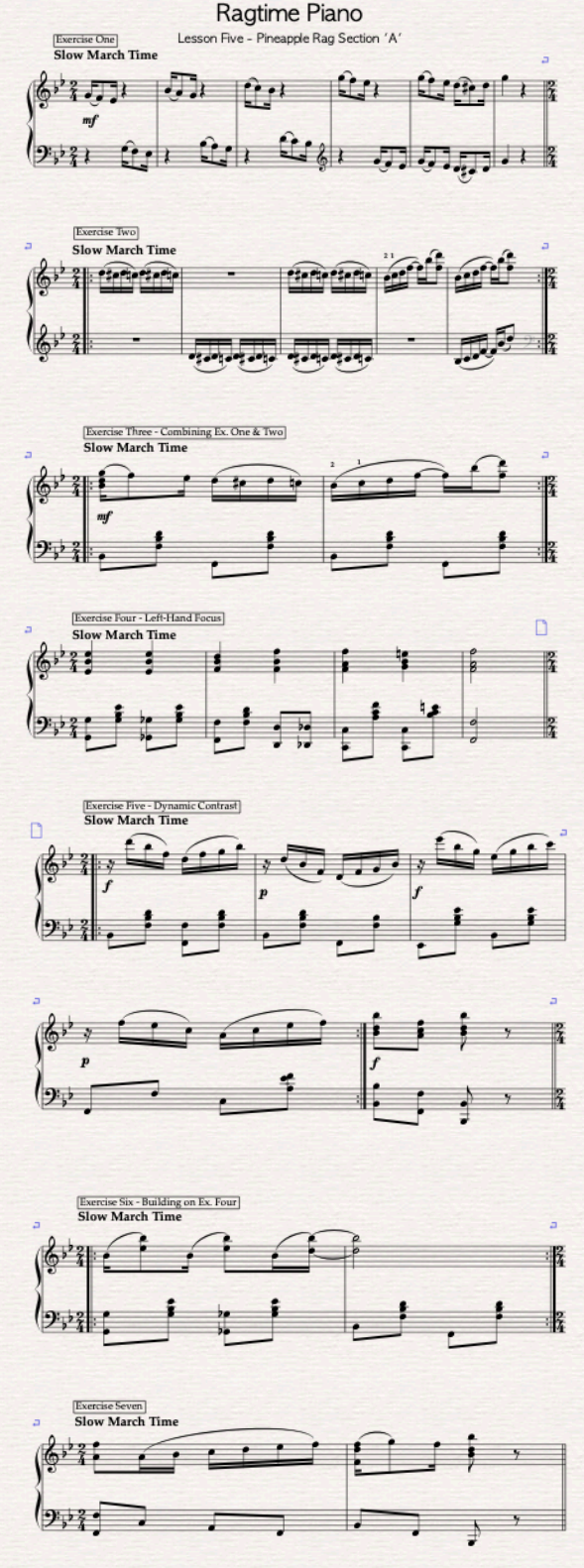
Lesson Six Pineapple Rag ‘Section B’
Lesson Six builds on the same approach we adopted in lesson five.
This second Section (‘B’) is also broken down into its challenging parts and ‘transformed’ into exercises to build strength, rhythmic accuracy, and ultimately a fluent performance.
Much of the music in Section B is similar to that of Section A; however many technical as well as stylistic challenges occur and should not easily be
overlooked.
One of the differences between Section A and Section B is that the harmony has shifted towards F major’s ‘dominant’ key.
Joplin is clever in using this key as he always adds the 7th (the E flat), ensuring that the feeling, harmonically speaking, is still towards Bb major.
What this means for us as performers are that Section B has a slightly brighter feel that perhaps should be reflected in the playing, aiming to bring a little lightness of touch to this Section of the rag.
Texturally Section B thickens up a little with more three and four-note chords.
These need careful handling so as not to make the Section too weighty.
When this is coupled with the continuing striding left-hand, this can present quite a challenge, especially when considering the use of dynamics too.
Tips:
Notice that the rhythm that features in ‘Exercise One is the one that runs like a thread through the whole of Section B.
If you take the time to learn this thoroughly, the Section will flow effortlessly.
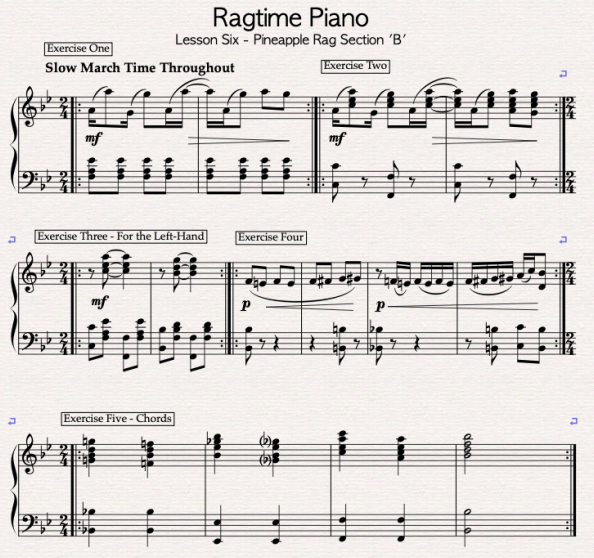
Lesson Seven – Pineapple Rag – Section ‘C’
In the next section of this Rag, you will notice that the key-signature changes from two flats to three flats.
This places the C Section in the key of E flat major.
As a rule of thumb, it’s always good to learn the scales and arpeggios of the piece you’re studying.
The thinking is simply that if you’re familiar or even fluent in playing these, then the music you’re playing will become more accessible as many of the ‘figures’ that in the Rag appear in the scales and arpeggios.
The C Section is relatively short, at only 16 Bars, but has a repeat just like the opening section.
The interplay between the left and right hands is more pronounced in this section and requires an ear for balance between the hands.
In a sense, you are almost aiming for a ‘question & answer’ effect between the two hands that are not part of the A Section.
There is also a challenging section written in the fourth bar of this section.
It’s challenging as Joplin asks the performer to play a short scale in 3rds that needs slow practice to be played securely.
The dynamics are more measured in the C Section alternating only from mp to me.
Variation in dynamics between these two markings is encouraged that feels right to you as you get to know the music.
Pedaling for this section (if you’re ready to try it out) ought to be from one bar to the next.
As previously mentioned, work on the Rag without the pedal initially, and when it is applied, use it sparingly.
This section is accessible to ‘cloud’ the interplay between the hands and the melody in the right hand.
This is particularly true given the mid-range of the melody.
The exercises in this lesson follow the same idea as in the previous lesson.
I have taken out the areas of Section B that will need thoughtful attention before the section is attempted all the way through.
Where appropriate, I have marked in fingerings that I hope will help the practice of each exercise.
Tips:
Make sure the tempo you choose is slow enough to count in quavers (eighth notes) at the start of your practice.
Vary the dynamics of each exercise to add variety and strengthen your finger control.
Listen carefully to the balance between the hands.
Use the ‘repeats’ as you feel works best for you. If you can play the exercise without repeating it, then don’t.
If a repeat is helpful, keep the tempo slow, and repeat three times in one session.
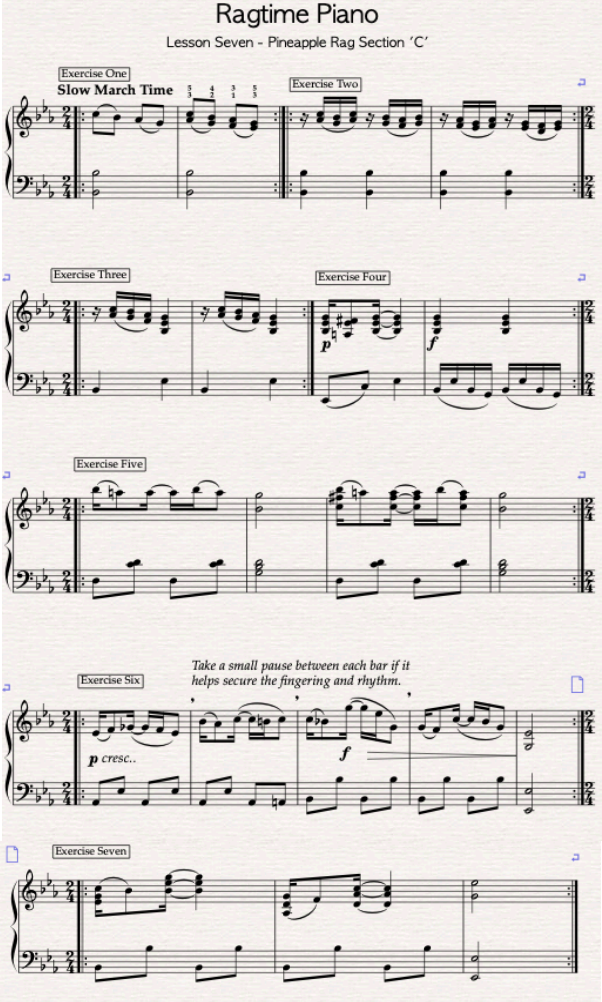
Lesson Eight – Pineapple Rag Section ‘D’
This is the final section of this rag.
The ever-inventive Scott Joplin does not disappoint during this ultimate part of the piece as he plays an unexpected harmonic trick shifting the key to C flat major, or enharmonically, B major.
The familiar rag rhythms continue to create a forward movement, and there is an increasingly challenging use of right-hand figures in 6ths and 3rds.
Following along and building on the previous lessons, I divide this section into various exercises that will enable you to play with fluency and control.
Always think creatively about each exercise.
Do you need to repeat it?
Could you add different dynamics?
How about trying the passage with different articulations?
Tips:
In Exercises three and four, once you feel confident to play them accurately and slowly, try playing one after the other.
Fingering in the more technically challenging passages has been added, but if you have an alternative you feel works better for you, go ahead.
If you want to extend your learning, you could work on scales and arpeggios in the key of B major.
Remember, don’t stick to one or two rhythmic patterns.
Use the patterns available in the piece you’re learning.
Try developing your own Joplin-style stride left-hand patterns and play your scales (or arpeggios) over the pattern.

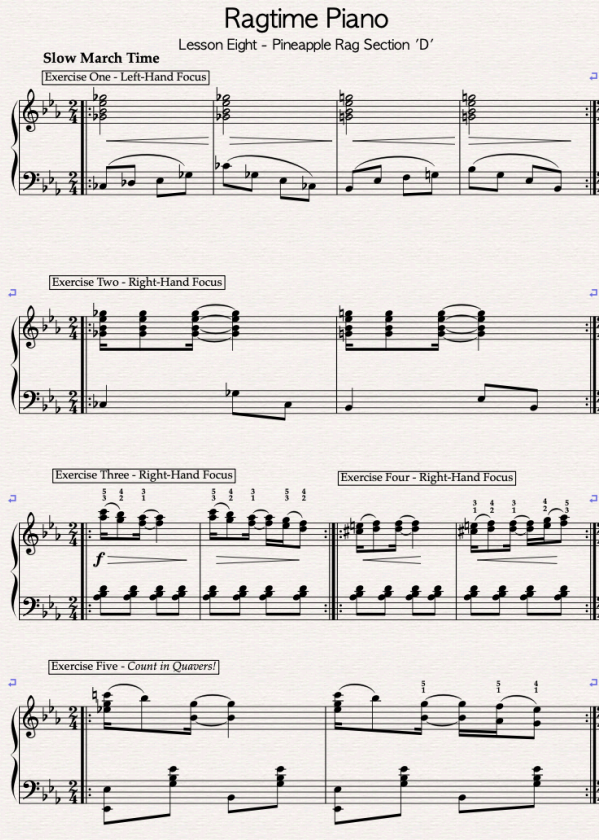
Lesson Nine – Pineapple Rag – Putting It All Together
In this lesson, the focus is to put into practice all the work you have been undertaking over the last eight lessons.
Even though you hopefully feel a sense of achievement already, try not to be tempted to approach the whole Rag too fast.
One of Joplin’s comments about playing Ragtime music was that it should not be played quickly.
You can easily find numerous examples of performers playing Ragtime music at speeds that seem like their lives depend on it.
This is not the spirit of the music.
And in this lesson, I would ask you to pause and think about how you wish to perform the Pineapple Rag.
While there are some guidelines in terms of performance direction, there is no detail in which you need to think to produce a convincing performance.
The phrase goes, ‘the devil is in the detail,’ which is valid for most performing arts.
Taking the time to smooth a phrase, shorten a staccato, or color a dynamic will turn a good performance into an excellent one.
Look back through all the exercises in the previous lessons and start to assemble your ideas and feelings about this Rag.
Don’t be afraid to experiment with different tempi, dynamics, and articulations until you feel you have reached a stage where the music makes sense.
If you’re able, record these stages and ask other people’s opinions if you’re happy to do so.
It is also very worthwhile researching other performances of the piece.
Listen critically and pick out the parts you like or don’t like, and use this to inform your own decisions about your performance.
Ultimately, have fun and never stop learning.
Lesson Ten – Additional Practice Materials
This final section is not so much a lesson as an opportunity for me to present extra material that I hope will be helpful as you explore the word of
Ragtime music.
You can ignore this and still have plenty of resources for learning The Pineapple Rag, but it may help you on your journey of discovery.
As you can see below, the exercises are each in the key of the Pineapple Rag.
This I have deliberately done to illustrate what I mean when I write practice scales and arpeggios in the key of your piece and using the rhythms of that
piece.
You could take the exercises further and include the relative minor (G minor), Eb major, and even C flat major plus their relatives.
Even if this wasn’t directly to support the performance of the Pineapple Rag, it would help your technique and other rags you may wish to master.
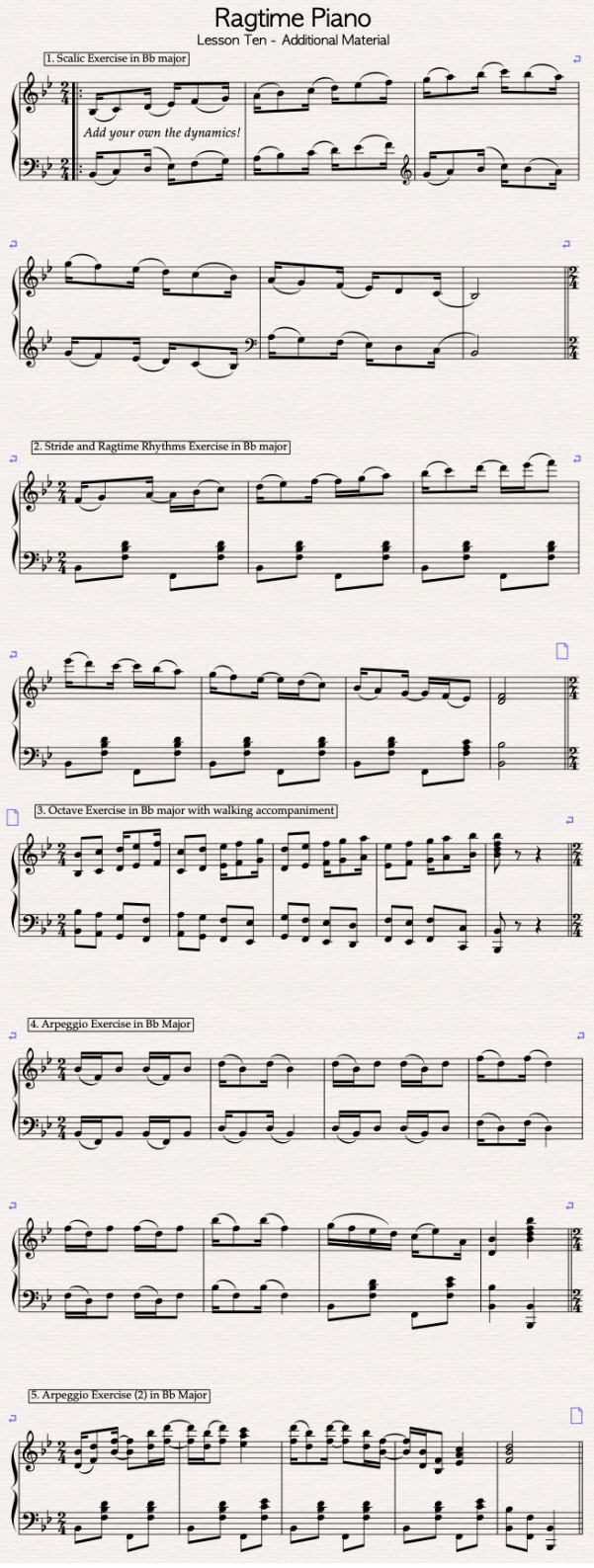
 If you wish to download the files to your desktop, simply right click the link below and select ‘save as’
If you wish to download the files to your desktop, simply right click the link below and select ‘save as’
Then select the location you wish to save the files to (either your DESKTOP or MY DOCUMENTS e.t.c.)
Once finished, simply unzip the files (PC use Winzip, MAC use Stuffit) and your files will be there.
All written material can be opened as a PDF.
All video files can be opened with VLC Media Player.
Select your download option below …
